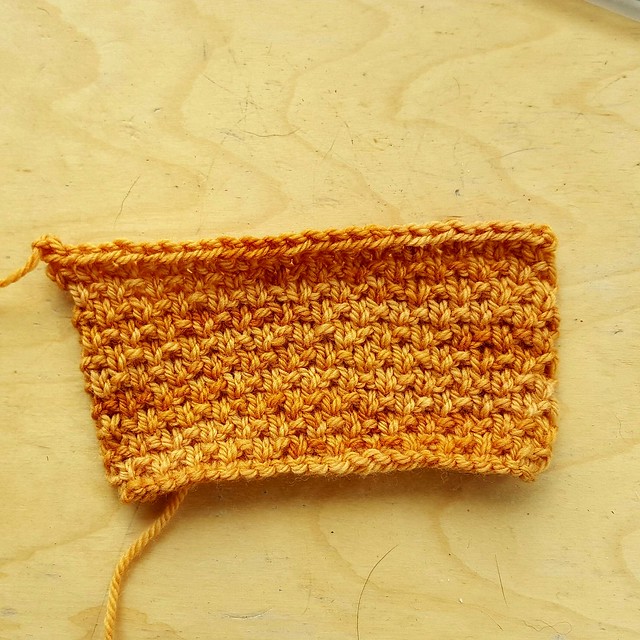Yarn substitution can be a very tricky thing. On the surface it seems like just picking a yarn with the same gauge should do the job but that is just the starting point!
I’ve had a few requests for substitutions for the Luwan KAL so I thought I’d do a little swatching and put my thoughts and some general information together for knitters.
Yarn varies is several different ways but the three most significant are; weight, construction and fibre blend. If you want to substitute a yarn within a pattern ideally all 3 of these items should be as close as possible to the original yarn used for the sample. Now if that’s not possible you can pick the items that are most important to you and swatch in the stitch pattern used.
This swatch will tell you a few different things:
- Do you get close to the original gauge?
- How does the fabric feel and move?
- Does the yarn do the stitch pattern justice/does it look good?
Lets break down these yarn characteristics and discuss each one separately.
YARN WEIGHT
It seems like this should be an easy one – pick a yarn that is either named the same or has the same weight, right?
However yarn names are very, very confusing! For Luwan we used a yarn that is technically a ‘dk’ weight yarn but if you look at dk (double knit) yarns they can range from 20 to 24 stitches per 4″ / 10 cm. Due to this I’d suggest watching the gauge rather than the name of the yarn, this will be the best indicator.
With this yarn you can see that using 4.5mm (US size 7) needles I get a gauge of 18 stitches per 4″ / 10 cm in pattern. This is obviously a bigger gauge than dk yarn but yet the stitches don’t appear to be loose? There are a couple of reasons for this; firstly the pattern stitch naturally creates a bigger gauge than stockinette stitch. But also this ‘dk’ yarn is both a heavy dk and a single ply yarn. When you hold the yarn it ‘fluffs out’ and takes up much more space than it seems like it should! This means that it looks great knit more loosely than it’s name would indicate. I’ll talk a bit more about the construction in the next section. So when looking at yarn weight look for either a heavy DK weight yarn or a light worsted yarn for best results.
YARN CONSTRUCTION
There are several different ways to make yarn. I’m definitely not a spinning expert but I’ve got enough working knowledge to get started and know how a yarn will behave.
The 2 main ways yarn is spun is either Woollen spun or Worsted spun.
With Woollen spun when the fibre is carded it’s allowed to remain scattered in different directions. This creates a yarn that will have loose hairs poking out but it makes a much lighter fluffier yarn. When you knit with Woollen spun yarn after blocking the yarn ‘blooms’, which means that it really fills in and softens the stitches.
Worsted spun has all the fibres lined up in the same direction. This creates a smoother but heavier yarn. You will have better stitch definition but you won’t get the ‘blooming’ effect after the yarn is blocked.
The yarn used in the Luwan KAL (Silky Single Targhee) is spun in a different way again. Both Woollen and Worsted spinning refer to yarns that are plied. This means that several strands of fibre are twisted together to form a strong stable yarn. This yarn however is a single yarn. This means that there is only a single strand of yarn twisting on itself. To give it a bit of stability and strength it is lightly felted which gives it a little firmness and durability. Often single yarns can be unbalanced, wanting to curl up on itself as you work. Fortunately the felting seems to help with this and this yarn didn’t have that issue. Due to the yarn being a single yarn it blooms very nicely when washed to create a nice full fabric.
YARN FIBRE
Silky Single Targhee is made from 70% Targhee wool and 30% silk. Wool is the dominant fibre in the yarn and you can feel that when you are working with it. Silk adds softness and a bit more weight as it is a heavy fibre.
For substituting you could comfortable use a yarn that is 100% wool. I think it would behave well enough to hold the stitch pattern. Silk does add a little bit extra though!
Lets take a look at a few swatches now to figure out how all the factors influence our final swatches.
The swatch below shows from top to bottom SHELTER, Dovestone DK, and the KAL yarn Silky Single Targhee. Both of the substituted swatches I did here are woollen spun which means that they have a hairier look. This creates a totally different looking stitch pattern! The Shelter ended up being too heavy and gave me much too big a gauge. The Dovestone DK however was spot on for both stitch and row gauge. It does look really different though! I suspect that woollen spun is a little too hairy to allow the stitch pattern to show through enough.

Below is another Blue Moon Fiber Arts yarn – Targhee Worsted in colour Gourdy. This is a plied yarn so the texture is a little different but I got both stitch and row gauge with it for Luwan so it could be a potential substitute if you didn’t want to use a singles yarn.

So now it’s in your court! What yarn will you use?




